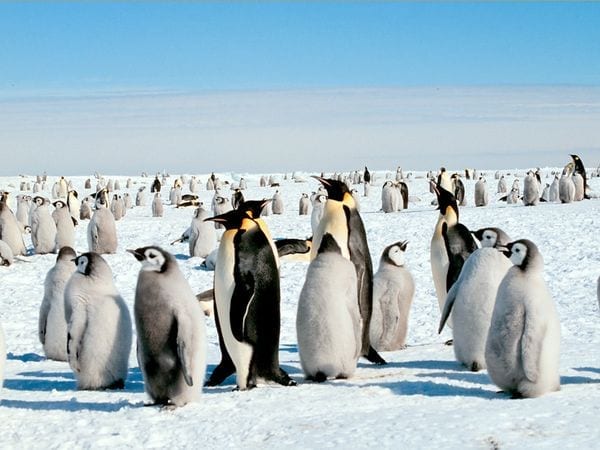
SCIENTISTS at the Zoological Society of London (ZSL) have devised a novel method to identify suitable new homes for animals under threat from climate change.
Conservation scientists used their knowledge on species ecology to create habitat suitability maps and correctly identify sites that will remain viable in the future regardless of changing climate. However, the key for success is to understand, and account for, the link between variation in species population size, climate and how the climate may change.
Almost half of all bird and amphibian species are believed to be highly vulnerable to extinction from climate change. Species in extreme or rare habitats such as the emperor penguin in the Antarctic and American pika in the USA have already experienced drastic declines in populations due to the impact of climate change on their home.
As climate changes, many species will need to move to a different location in order to survive. For species that aren’t able to do this naturally, the only chance of survival is a helping hand through the use of translocations.
The research is published today (6 September) in the Journal of Applied Ecology.
Dr Nathalie Pettorelli, ZSL’s climate change coordinator and senior author on the paper, says: “Climate change poses a worrying threat to many animals, and relocating vulnerable species to new and more suitable habitats may be the only way to protect them. However, this is an extreme conservation action, which needs to be thoroughly justified, and requires clear guidance on where threatened populations should be moved. Our research shows how these key requirements can be met.”
The team used the hihi bird as an example because of the conservation success which came after efforts put into its relocation since the 1980s. Yet, despite large investments into its protection, climate change is now posing a significant threat to its future survival.
Dr Alienor Chauvenet, lead author of the study, says: “All current hihi populations are surrounded by either a large stretch of water or unsuitable habitat such as farmland or cities with plenty of non-native predators. This isolation makes it very perilous for them to move and individuals attempting to relocate naturally are unlikely to survive.
“Our work shows that assisted colonisation may be the only way to guarantee the survival of this unique species under climate change,” Dr Chauvenet added.
The Latest Bing News on:
Habitat suitability maps
- 21st Century Climate Change Threatens on the Brown Bearon May 13, 2024 at 2:52 am
We determined that the variables contributing to the habitat suitability model of Brown bear are annual precipitation amount, the average annual air temperature, the precipitation amount of the ...
- Maharashtra Pench records 1st sighting of leopard cat in Central Indiaon May 12, 2024 at 8:17 pm
Maharashtra Pench, the Land of Mowgli, records the first sighting of a leopard cat in Central India. This discovery adds to the biodiversity of the region and highlights the importance of conservation ...
- Global warming may boost mosquito habitats, study findson May 8, 2024 at 1:42 pm
The study was recently published in the Journal of Climate Change and Health. "We found that all nine species in our model responded resiliently to climate change, which tells us that ...
- NASA is helping protect tigers, jaguars, and elephants—here's howon May 3, 2024 at 10:19 am
As human populations grow, habitat loss threatens many creatures. Mapping wildlife habitat using satellites is a rapidly expanding area of ecology, and NASA satellites play a crucial role in these ...
- 23 Google Maps Tricks You Need to Tryon April 27, 2024 at 5:00 pm
Google Maps is the Swiss Army Knife of apps, chock-full of navigation, geospatial-search, and customization tools. These tips and tricks will help you unlock its full potential. My title is Senior ...
- How to use Google Maps offlineon April 22, 2024 at 4:59 pm
Google Maps is one of the most reliable navigation services available, but it’s not without its faults. One of the most significant issues is that it works best with a solid data connection ...
- Publish your Google Maps drafts now or forever hold your peaceon April 16, 2024 at 5:01 pm
Draft reviews on Google Maps are being phased out soon, so make sure to publish any remaining reviews before July. Users can't save new drafts on Google Maps anymore, and old drafts will be ...
- I tested Google Maps against Apple Maps to see which is actually betteron April 5, 2024 at 8:55 pm
Both Google Maps and Apple Maps have their ups and downs, but there are some things each does better than the other. We break it down. Your browser does not support ...
- Habitat Suitability and Distribution Modelson January 23, 2024 at 10:01 pm
Ramos Gutiérrez, Ignacio Martínez Labarga, Juan Manuel Araújo Díaz, José Fernández de Castro, Alejandro G. and Moreno Saiz, Juan Carlos 1970. Expansion of "Himantoglossum robertianum" (Orchidaceae) in ...
- Habitat Suitability Maps (IMAGE)on October 27, 2021 at 10:55 am
VIMS’ Habitat Suitability Index and maps—like these for Bay anchovy—reveal seasonal changes in the areas within Chesapeake Bay that provide suitable conditions for forage species.
The Latest Google Headlines on:
Habitat suitability maps
[google_news title=”” keyword=”Habitat suitability maps” num_posts=”10″ blurb_length=”0″ show_thumb=”left”]
The Latest Bing News on:
Habitat suitability
- Minister Dangiwa calls for collaboration between Shelter Afrique and UN-Habitat to tackle housing crisis in Africaon May 13, 2024 at 3:23 am
Lauding the move, Shelter Afrique Development Bank Managing Director Thierno Habib Hann said by joining forces, the two institutions will be able to leverage their complementary strengths to implement ...
- 21st Century Climate Change Threatens on the Brown Bearon May 13, 2024 at 2:52 am
We determined that the variables contributing to the habitat suitability model of Brown bear are annual precipitation amount, the average annual air temperature, the precipitation amount of the ...
- MBRSC announces commencement of new phase of second analog study with Emirati crew member Shareef AlRomaithion May 11, 2024 at 12:07 pm
Shareef AlRomaithi entered the Human Exploration Research Analog (HERA) habitat at NASA’s Johnson Space Center in the USA at 2 AM (UAE time) on Saturday ...
- What is ‘Project Nilgiri Tahr, Tamil Nadu’s multi-pronged initiative to save state animalon May 6, 2024 at 1:18 am
The 5-year project has gathered pace with conclusion of a survey that aims to find its population, its habitat, and introduce measures so that the ungulate does not go extinct ...
- NASA is helping protect tigers, jaguars, and elephants—here's howon May 3, 2024 at 10:19 am
As human populations grow, habitat loss threatens many creatures. Mapping wildlife habitat using satellites is a rapidly expanding area of ecology, and NASA satellites play a crucial role in these ...
- Ximena Velez-Liendo is saving Andean bears with honeyon April 30, 2024 at 11:13 am
By training beekeepers, biologist Ximena Velez-Liendo is helping rural agricultural communities of southern Bolivia coexist with Andean bears.
- Habitat brings back archive "classics" for 60th anniversary collectionon April 28, 2024 at 5:00 pm
British furniture retailer Habitat has revealed its 60th-anniversary collection, which features collaborations with emerging designers alongside revived archive pieces like the chicken brick.
- Rezoning for Habitat Home approvedon April 24, 2024 at 3:23 pm
Apr. 24—ANDERSON — The Anderson Plan Commission has approved a rezoning for the construction of a Habitat for Humanity home on Forkner Street. The Plan Commission Tuesday approved the rezoning ...
- Voting open for New York’s next Habitat and Access Stampon April 23, 2024 at 3:14 pm
The Habitat and Access Stamp is a fundraising sticker that people can purchase for $5 with their New York sporting license or on its own. The stamp was created by legislation in 2002 and features ...
- Broward schoolteacher comes closer to achieving dream of home ownership as part of 5th Annual Habitat CEO Buildon April 20, 2024 at 5:00 pm
The Fifth Annual Habitat for Humanity CEO Build brought together business leaders in Pompano Beach on Saturday to help build Habitat homes and give back to people who are the heart and soul of ...
The Latest Google Headlines on:
Habitat suitability
[google_news title=”” keyword=”habitat suitability” num_posts=”10″ blurb_length=”0″ show_thumb=”left”]










